Explore your water with How’s My Waterway
Current Issues Impacting Michigan’s Water Quality
Microplastic pollution in the Great Lakes
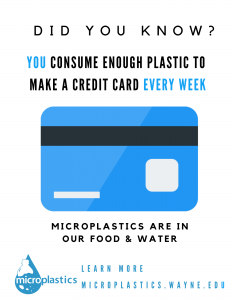
Plastic is in our food and water.
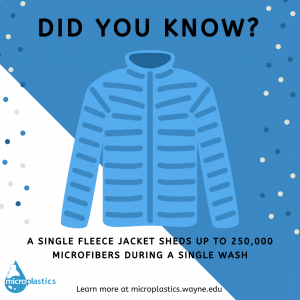
Plastics are in our clothing.
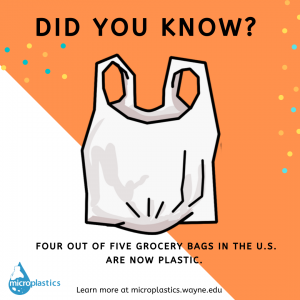
Plastic grocery bags contribute to microplastic pollution in our Great Lakes.
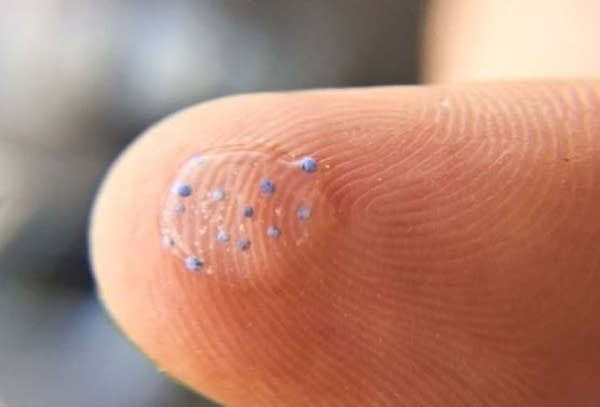
Close up of plastic microbeads on person’s finger tips.
What are microplastics?
When most people think of plastic pollution, they think of huge floating islands of plastic waste in oceans. And they are correct. The oceans host vast amounts of plastic waste that breaks down in water and harms aquatic life. It also breaks down in our rivers and lakes, polluting our home waters far from any ocean. Some of it is big enough to see and the rest are pieces so small, you need a microscope to see them.
Microplastics are tiny pieces of plastic (less than 5 millimeters) mostly invisible to the naked eye. They are the miniscule plastic fragments that are shed from synthetic fibers, fall off decomposing plastic bottles and bags, and are intentionally manufactured into some toothpastes and lotions. These tiny particles easily pass through water filtration systems and end up in the ocean and Great Lakes, posing a potential threat to aquatic life.
Around the globe humans have been ingesting microplastics. Very little is known about the impacts they have on human health. We ingest them through our food, water, beer, even breathing in dust. A recent study showed that we each take in about 5 grams of plastic a week, or basically the equivalent of a credit card. More research is needed about how plastics impact our health, what contaminants they pick up and introduce to our systems, and which plastics have stronger impacts over others so we can strategically address the issue.
Top 5 Things You Can do to Reduce Pollution From Microfibers
- Get a filter for your washing machine (330 microns or less, like the Fitrol or Lint Luv) so it captures microplastics before the waste water enters the waste water treatment (or septic) system.
- Use laundry devices that capture fibers during the wash cycle such as Cora Balls or GuppyFriend Bags.
- If you’re in the market for a new washing machine, get a front load machine instead a top loader (fibers shed less in front load machines.) Ask washing machine companies to include filters with their products, like the Xeros filtration system.
- Wear clothes made with natural fibers or look for synthetic/cotton blends, which shed less, and try to wash your synthetics less frequently.
- Contact your favorite large clothing manufacturer (those that use synthetic fibers, like athletic clothing) and ask them what they are doing about microplastic pollution from their synthetic fiber products.
- Be sure to recycle plastic/reduce overall use and do not litter. Use a refillable water bottle, especially if going to the beach. Disposable water bottles are sometimes left behind, contributing to microplastic pollution in the Great Lakes. Always do a sweep when leaving any recreational spot, beach, park, etc. to be sure you didn’t leave any plastic behind.
Click here for more information on microplastics pollution
Failing Septic Systems Are a Monster of a Problem
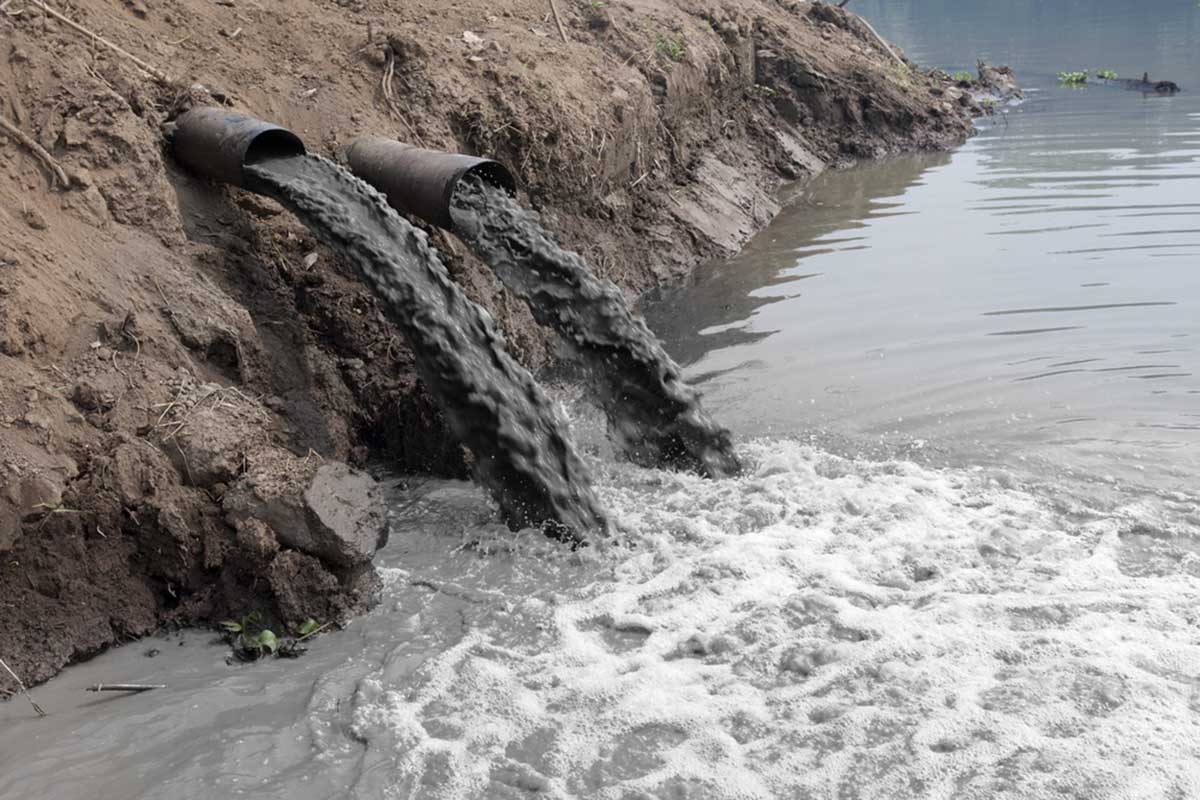
Waste being directly discharged into a waterway through a pipe.
Michigan is the only state in the nation without uniform standards governing how on-site sewage treatment systems are designed, built, installed and maintained. Filling this gap, health officials say, would address the single biggest problem with septic systems: The lack of maintenance.
The State of Michigan estimates that roughly half of its rivers and streams exceed the safety standard for concentrations of E. coli bacteria. Escherichia coli (E. coli) is a type of bacteria that serves as a key water quality indicator. Because E. coli grows naturally in the gastrointestinal tract of warm-blooded animals and humans, its presence in a water sample tells us that fecal pollution has reached that water source by some means.
What does this have to do with septic systems? Septic systems are a form of onsite sewage treatment common in rural Michigan communities, homes surrounding lakes, and throughout some suburban communities as well.
Household wastewater is sent to a large tank, where anaerobic bacteria break some of it down before allowing the water to flow out of the system into a drainfield for further filtration by the soil.
If we want to keep E. coli and other pathogens out of our waterways, we need to address the problem of septic systems that may be failing to adequately treat our wastewater.
The Michigan Department of Environment, Great Lakes & Energy (DEGLE) estimates there are 130,000 failing systems currently operating in Michigan. That represents about 1-in-10 of more than 1.3-million systems installed statewide.
DEGLE further estimates that Michigan’s numerous failing septic systems release upwards of 31 million gallons of raw sewage every day into our groundwater.
Sometimes a failing septic system is obvious to the homeowner and is repaired or replaced quickly. But system failures can also easily go unnoticed and unrepaired for years.
County health departments regulate where septic systems can be installed, but the regulations end there for much of the state. Only 11 of Michigan’s 83 counties have gone beyond existing state regulations and enacted programs designed to detect failed septic systems and force repairs.
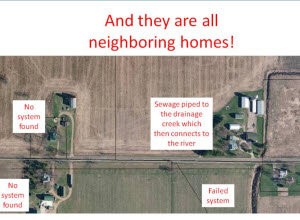
Health officials discovered that none of the four houses shown in this aerial photo had proper sewage disposal systems. Two of the houses had no septic system at all, one had an illegal system and one was discharging raw sewage to an agricultural drain that fed into a creek. (courtesy image/Barry-Eaton District Health Department)
Our water is a shared resource. What one person does on their property, impacts the water quality for all the surrounding neighbors. We have a shared responsibility to maintain our septic systems for the health of Michigan’s residents.
So, what can be done? Septic tanks should be pumped out every three to five years to prevent back-ups. The average lifespan of a septic system is about 20 years, according to government and industry officials. Replacing a failed septic system costs between $5,000 and $20,000. It is often more cost effective to get your septic system pumped and maintain it than to pay to have one completely replaced.
As far as a statewide septic code goes, there is a bipartisan effort in the works that may at last put this commonsense safeguard in place for our clean water.
Click here to learn about the septic system research done at an MSU lab.
Lake Erie Algae Blooms: Polluting Our Drinking Water
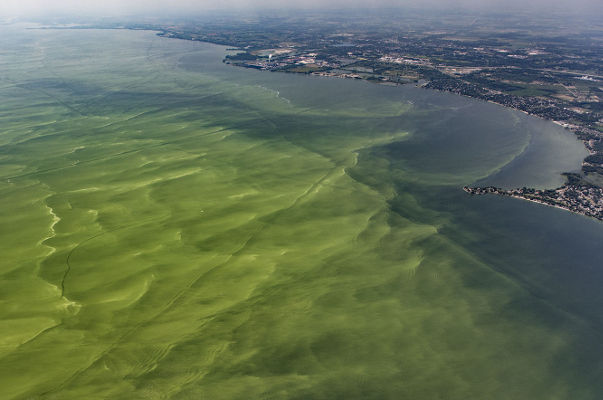
Aerial photo of a large green algae bloom in Lake Erie.
Lake Erie’s algae blooms are caused by runoff pollution. This type of pollution occurs when rainfall washes fertilizer and manure spread on large farm fields into streams that flow into Lake Erie. This fuels a bumper crop of algae each year that can make water toxic to fish, wildlife, and people.
Each summer, communities and businesses around Lake Erie worry about and plan for toxic algae blooms, wondering if the algae will:
- pollute their drinking water,
- harm the region’s vital tourism economy, and
- prevent residents and visitors from enjoying boating, swimming, and visiting Lake Erie shorelines
Scientists report that reducing the amount of runoff pollution will significantly reduce Lake Erie algae blooms and improve the lake’s health. Unfortunately, very few rules are in place to limit runoff pollution from big farms and landowners who apply fertilizer to their lawns.
One way you can help reduce the amount of runoff pollution entering the Great Lakes is by using phosphorus free fertilizer. Visit the homeowner tool kit page for more information.
PFAS Contamination: Michigan’s Biggest Environmental Crisis in Decades
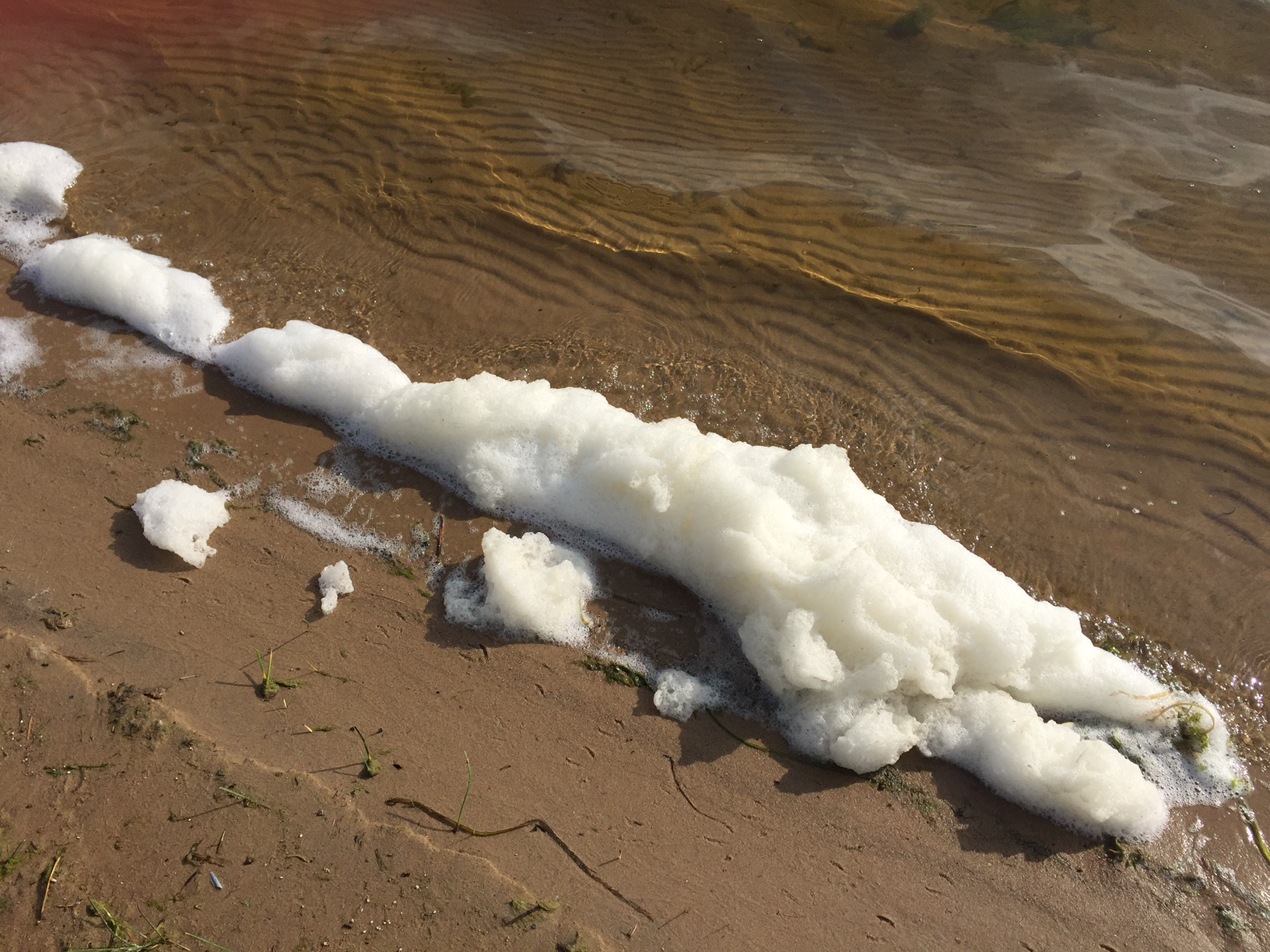
PFAS foam on beach shoreline.
PFAS is Michigan’s most widespread, serious contamination problem since the PBB crisis of the 1970s. Thousands of Michigan residents’ water supplies have been impacted, and the full scope of the contamination from these so-called “forever chemicals” is not yet known. Soil and surface waters are also contaminated in many places, and people’s exposures may have come from consumer products in years past.
Michigan has tested more than 1,700 public drinking water supplies statewide for PFAS compounds — every public water system (even down to a mobile home park with 25 users), every tribal water system, every school and day care/Headstart with its own well. Regulators also have tested residential wells in known areas of PFAS contamination.
What is PFAS?
Per- and polyfluoroalkyl substances (PFAS), sometimes called PFCs, are a group of chemicals that are resistant to heat, water, and oil. PFAS have been classified by the U.S. Environmental Protection Agency (EPA) as an emerging contaminant on the national landscape. For decades, they have been used in many industrial applications and consumer products such as carpeting, waterproof clothing, upholstery, food paper wrappings, firefighting foams, and metal plating. PFAS have been found at low levels both in the environment and in blood samples of the general U.S. population. These chemicals are persistent, which means they do not break down in the environment. They also bioaccumulate, meaning the amount builds up over time in the blood and organs.
Where is PFAS found?
Though largely phased out of manufacture and use in the U.S. by 2015, people were —and potentially still are — being exposed to PFAS today. Here’s where PFAS compounds can be found:
- Food packaged in PFAS-containing materials, processed with equipment that used PFAS, or grown in PFAS-contaminated soil or water.
- Commercial household products, including stain- and water-repellent fabrics, nonstick products (e.g., Teflon), polishes, waxes, paints, cleaning products, and firefighting foams (a major source of groundwater contamination at airports and military bases where firefighting training occurred).
- The workplace, including production facilities or industries (e.g., chrome plating, electronics manufacturing or oil recovery) that used PFAS.
- Drinking water, typically localized and associated with a specific facility (e.g., manufacturer, landfill, wastewater treatment plant, firefighter training facility).
- Living organisms, including fish, animals and humans, where PFAS have the ability to build up and persist over time.
What are the health concerns associated with PFAS?
Knowledge of how PFAS compounds — of which only a handful have been studied — harm health is still evolving, with many compounds not yet even evaluated. What’s known so far are the following health risks:
- Pregnancy-induced hypertension/pre-eclampsia (PFOA, PFOS)
- Liver damage (PFOA, PFOS, PFHxS)
- Increases in LDL or so-called “bad” cholesterol (PFOA, PFOS, PFNA, PFDeA)
- Increased risk of thyroid disease (PFOA, PFOS)
- Decreased antibody response to vaccines (PFOA, PFOS, PFHxS, PFDeA)
- Increased risk of asthma diagnosis (PFOA)
- Increased risk of decreased fertility (PFOA, PFOS)
- Small decreases in birth weight (PFOA, PFOS)
The International Agency for Research on Cancer has concluded that PFOA is possibly carcinogenic to humans. Increases in testicular and kidney
cancer have been observed in highly exposed humans.
There is concern regardless of whether you have a private drinking water well or are on a municipal or community water system. The State of Michigan tested community water supplies throughout Michigan for the presence of PFAS compounds. For data on the findings in your community, visit www.michigan.gov/pfasresponse and then click “Testing and Treatment” and “Statewide Testing Initiative.” The state has also directed the testing of residential wells in many of the known areas of PFAS contamination. Click here to learn more about PFAS and what the Michigan PFAS Action Response Team (MPART) is doing to address this issue.
What is Stormwater and Why is it a Problem?
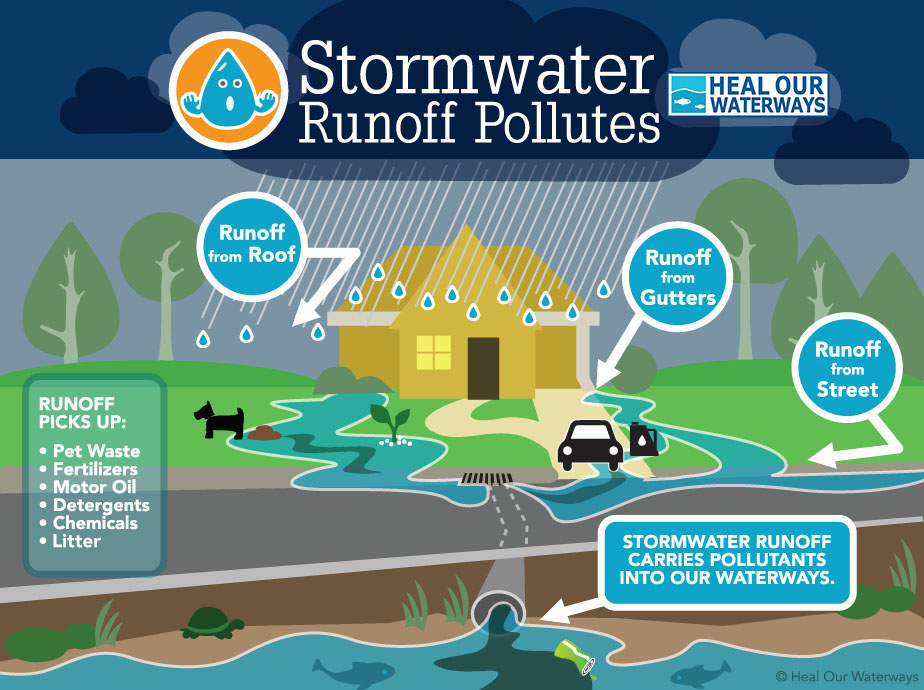
- When it rains, soil will erode and travel into local waterways. This clouds water and degrades habitat for fish and water plants.
- Nutrients such as phosphorus and nitrogen from fertilizers and animal wastes promote the growth of algae, which crowd out other aquatic life.
- Toxic chemicals such as antifreeze and oil from leaking cars, carelessly applied pesticides, and zinc from galvanized metal gutters and downspouts threaten the health of fish and other aquatic life.
- Bacteria and parasites from pet, waterfowl and other animal waste can affect nearby inland lakes and streams.
- As many people have discovered, stormwater can be a problem closer to home, flowing into basements, where it can be difficult and hazardous to clean up.
- Stormwater can also flow down an abandoned well or poorly sealed well casing (pipe) and contaminate drinking water.There are many ways to reduce the risks posed by stormwater including stewardship practices that keep the pollutants out of stormwater as well as best management practices to reduce the amount of stormwater runoff. Go to the take action page to see how you can help reduce harmful contaminants from getting in the water supply.
Non-point source pollution generally results from land runoff, precipitation, atmospheric deposition, drainage, seepage or hydrologic modification. The term “non-point source” is defined to mean any source of water pollution that does not meet the legal definition of “point source” in section 502(14) of the Clean Water Act. That definition states:
The term point source means any discernible, confined and discrete conveyance, including but not limited to any pipe, ditch, channel, tunnel, conduit, well, discrete fissure, container, rolling stock, concentrated animal feeding operation, or vessel or other floating craft, from which pollutants are or may be discharged. This term does not include agricultural storm water discharges and return flows from irrigated agriculture. Stormwater falls in the non-point source category.
Michigan’s Outdated and Dangerous Combined Sewer Systems
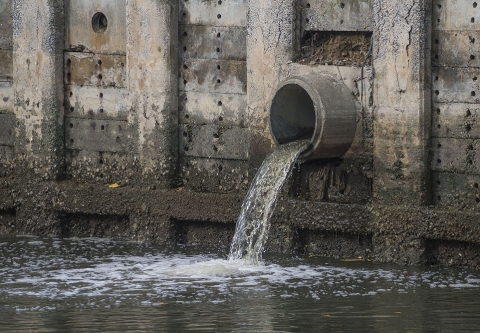
Combined stormwater and sewer pipe draining directly into a waterway.
Many of Michigan’s urban and suburban areas expanded rapidly between the 1920s and the 1950s — an era with different priorities for water management. Many of Michigan’s water systems were originally built as combined systems, meaning the pipes carried both stormwater and waste water. These systems discharged all water directly into local lakes, rivers, and streams, without treatment. Wastewater treatment centers were built later, and the combined sewer pipes were redirected there for the water to be processed before being released back into the water table. Starting in the mid-1950s, best management practices changed. Systems built after that generally had separated systems, where stormwater and waste water used separate pipes entirely.
Michigan, however, still has a few municipalities that have outdated combined sewer systems. The biggest problem with combined systems is that during rainfall events the water flow often exceeds the systems’ capacity. When the systems’ capacity is exceeded, the water is discharged directly into local waters without treatment. This polluted water carries with it bacteria, chemicals, and other pollutants that harm our rivers, streams and public health. These combined sewer overflows (CSOs) contribute an average of 5.7 billion gallons of raw sewage into our Michigan waterways annually. The numbers are even worse if we include partially treated sewage.
Many municipalities have already separated their sewer and stormwater systems. For instance, the City of Grand Rapids, separated their sanitary sewer pipes from storm sewer pipes- a project which began in 1991 and ended in 2015. Altogether, the project in Grand Rapids cost $400 million (which was mostly paid for by municipal bond). The project created hundreds of good-paying jobs, and most importantly, stopped the annual flow of millions of gallons of raw sewage into the Grand River and ultimately, Lake Michigan.
Investing in water infrastructure is essential to ensuring the health of our people, wildlife and the Great Lakes.
Aquatic Invasive Species impact water quality
What are invasive species?
Aquatic invasive species (AIS), also known as “nuisance” or “exotic” species, are non-native species that threaten the diversity or abundance of native species due to their rapid population growth, causing ecological or economic impacts. Invasive species often thrive in human-altered environments.
Why care about AIS?
Invasive species are the second leading cause of species extinction and loss of biodiversity in aquatic habitats throughout the word. Single aquatic invasive species,like Hydrilla, Carp and Zebra Mussels, can crowd out entire communities of native species.
Aquatic invasive species also take an economic toll. Experts estimate that invasive zebra and quagga mussels cost power and water industries 5 billion dollars every year. Companies must pay to remove mussels from clogged filters, pipes, and water delivery systems.
Impacts of aquatic invasive species:
- Reduce fish populations
- Ruin boat engines
- Jam steering equipment
- Make lakes and rivers unusable for boaters and swimmers
- Increase operating costs of drinking water plants, power plants, dam maintenance, and industrial processes
- Reduce native species
- Degrade ecosystems
- For example, Common carp feeds by searching through underwater vegetation. This feeding habit uproots plants which muddies the water. This makes it hard for other fish to see and destroys the food and cover for other fish.
How do AIS spread and how do to stop them?
Human activities play a large role in the spread of invasive species. Legal and illegal fish stocking, improper ship and boat maintenance, and improperly cleaned recreational or scientific equipment all contribute to the spread of invasive species. Below, find out what you can do to stop the spread of invasive species.
Spread the word not the AIS
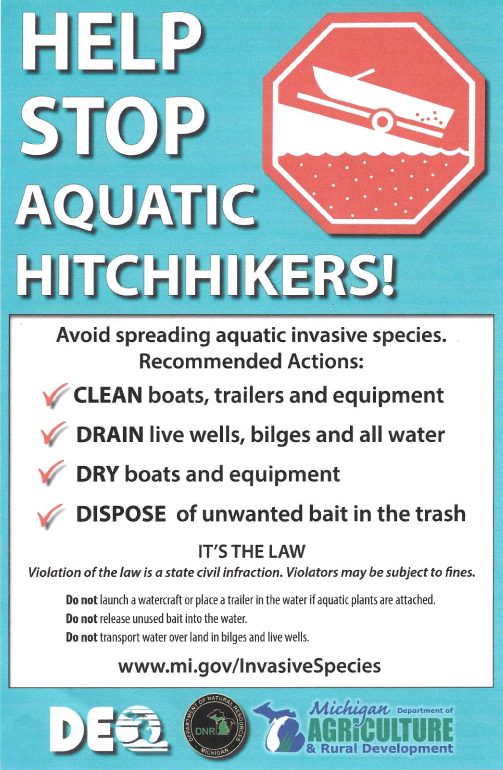
Once they are established, control of invasive species can be extremely difficult and expensive, if not impossible. By telling just one other person about the risks of aquatic, like a neighbor or friend, you can help raise awareness and protect our water.
Clean waders, footwear, fishing gear and watercraft thoroughly via the steps above.
1) rinse
2) wash with 409, bleach or lysol
3) Let thoroughly dry
Don’t release aquarium fish, live bait, or other exotic animals or plants into the wild. If you plan on owning an exotic pet, please do your research before committing to take care of it.
When you are buying plants for your yard or garden make sure they are not invasive species. Replace invasive species with non-invasive plants or native plants. Contact your local nursery for more information.
Excess salt is polluting our Great Lakes
While it is important to keep the public safe from ice on the roads, its also important we ensure we are not harming our water quality. Some cities have already taken steps to reducing how much salt they are putting on the roads. Experts say that by applying a little bit of salt before it snows may actually be the best case scenario. Read below for some tips on how to reduce salt usage.
